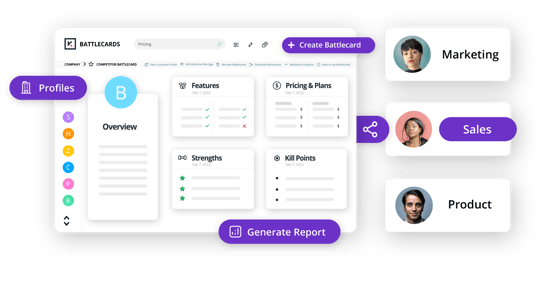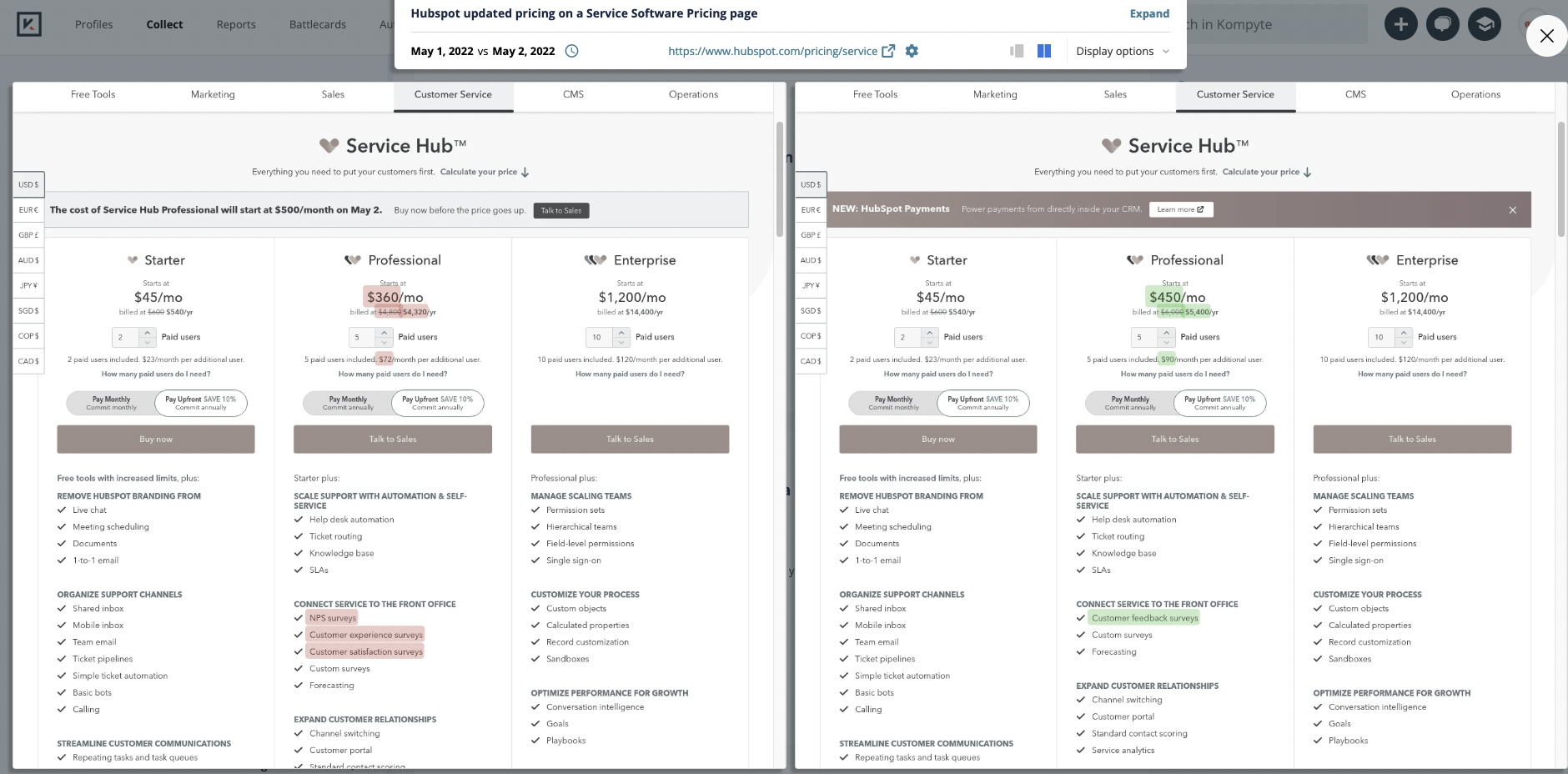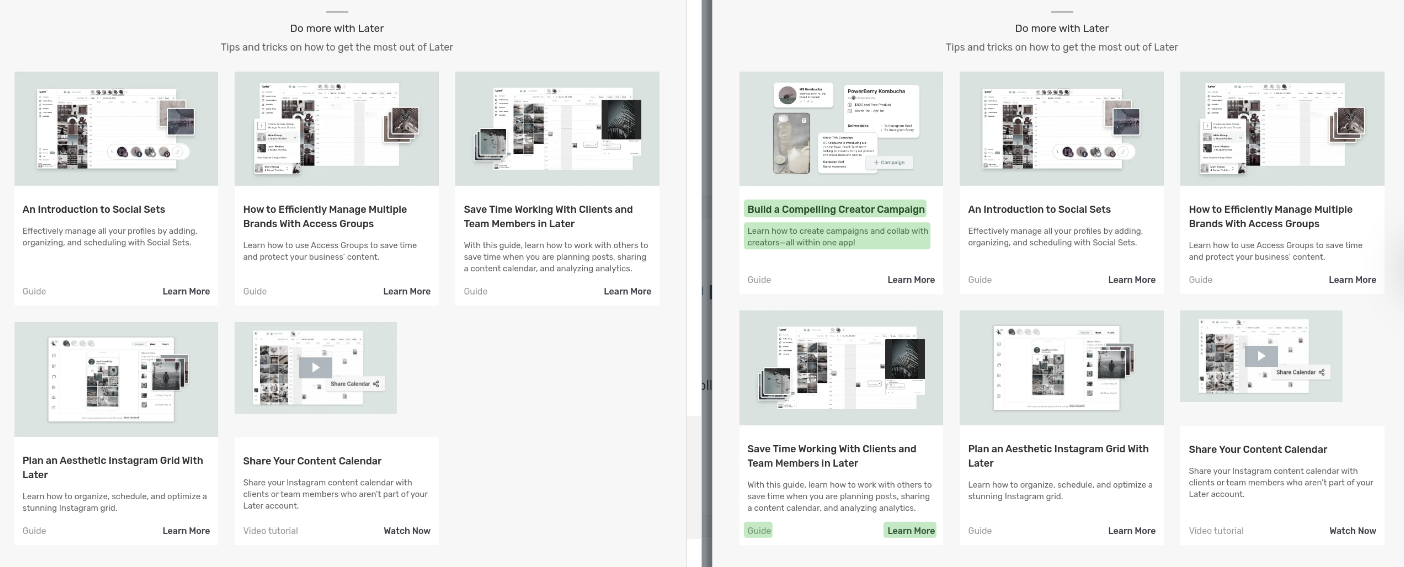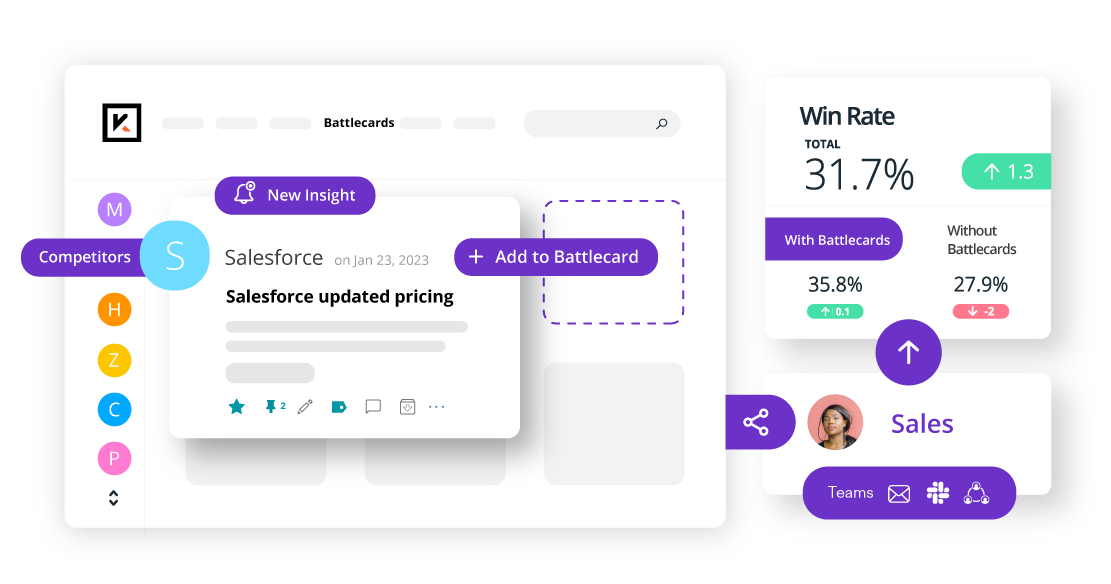Tips to uncover top performing messaging through social media
Social media marketing is more than posting and sharing content. Learn how you can use social to strategically develop your messaging with industry...
With inflation rising, the companies that survive know how to hit sales quotas no matter what. Here are eight ideas that can help, with tips from business leaders.

No one ever said that being a sales director or leader is easy. The market can change at any given moment, yet your job requirements remain the same - you must hit those sales quotas.
It looks like inflation will be with us for a while and may be followed by a period of recession, which means your job just got harder. You’ve likely already seen your budget come under more scrutiny and know that most of your clients will be looking for ways to cut down on their spending.
All is not lost though.
Wise collection and application of competitive intelligence as well as an empathetic approach are key to meeting sales quotas despite high inflation. Below are some tried and tested methods for continuing to reach sales quotas despite tough economic times with first-hand accounts from a wide range of business leaders who’ve been there and lived to tell the tale.
Whenever there is a sudden increase in prices most of us need to cut costs in order to continue paying for the essentials. You may see this in your personal budget. Higher grocery costs eat (no pun intended) into discretionary spending on things like entertainment. Rising gas prices might mean that home improvement project must wait a bit longer.
Steve Hertz at Gartner sums up the pain we’re feeling:
“Even as it (inflation) is driving up quota attainment through its effects on price, it can also have the opposite effect by reducing the number of deals that actually close. In an inflationary environment, customers may adopt a more conservative approach to spending, leading to longer sales cycles and lower absolute (constant price) sales.”
To avoid being a casualty of budget cuts and longer sales cycles, you and your salespeople must position your product as something that is absolutely necessary. Which means your sales team likely needs some updated training.
Aside from being able to articulate the value of your product, they need to make it crystal clear the reasons why YOUR product is the one that is essential to their success. This means you need to know your competitors’ products, messaging, features, and weaknesses inside and out.
Ongoing training is essential as is regularly updating sales Battlecards or other reports your sales team references on calls in order to more effectively highlight the value and ROI of your product.

Here is a (completely fictionalized) Battlecard which highlights the ROI, pricing, and competitive advantages of Later’s social media scheduling tool. Having this information consistently updated and available to the entire sales team is never more important than in a competitive market at a time of high inflation.

Remember, your competitors are dealing with the same challenges you’re facing right now. Knowing how they’re handling them can help you make better decisions, get inspiration for your own marketing and sales, or take advantage of something they missed.
A competitive intelligence program helps you track and share these important findings with the team. Have your competitors changed a key page? Did they receive some new (good or bad) customer reviews or post a job opening for a key role? All of these things can help you see what your competition is up to, but particularly when you’re dealing with quota-busting inflation, you want to keep a close eye on changes to pricing, competitor positioning, and product features.
Likely you know your competitors’ product positioning and messaging nearly as well as you know your own. But in a time of tight budgets and increasing inflation, it’s more important than ever to know when they make a change. Changes in positioning may come as a result of insights gathered on sales calls, user calls, new features added, or may pop up because something just isn’t working given the changes in the economic environment.
Your competitors aren’t the only ones who can learn from their positioning and messaging tests. Watch for changes to your competitors’ key pages, new ad campaigns, and read their newsletters to see where they may be trying something new.
Here, Kompyte shows how Tailwind changed the heading on their email services page.

Keep an eye on changes made to see if they double down on new messaging or revert to the original. You might choose to run a small-scale test of something similar (running A/B tests on ads is great for this), or wait to see if they keep the new messaging.
To keep an eye on what your competitors are doing, make a list of important pages, and take advantage of Meta’s ad transparency features to see the Facebook ads they’re running. You can also subscribe to newsletters, which are often full of clues as to messaging and positioning adjustments.
You can do this manually, but most people find that even with someone responsible for sales enablement, this is often done sporadically at best. It’s also challenging to make sure your sales team is aware of these developments.
You may need to increase your pricing just like everyone else. But make sure you know what “everyone else” (and by “everyone else,” we mean your competition) is doing first. If you can NOT be the first one to raise prices, that may give you an edge while it lasts. But, when you do adjust pricing, it’s nice to be able to tell your prospects that you’ve seen similar increases throughout the industry and even to give specific amounts if needed.
While no one wants to have to do it, sometimes it can’t be helped. From Arkadiusz Terpilowski, Head of Growth & Co-Founder, Primetric:
“It's important to monitor market trends to determine whether a price increase or decrease is necessary. You can also look for opportunities to reduce costs without sacrificing quality. Review your supply chain and renegotiate terms with vendors if possible.
You may also want to consider offering discounts or promotions to incentivize customers. Last, look for new or untapped markets and invest in marketing efforts to reach those audiences.
By taking advantage of these strategies, you can help manage inflationary pressures and reach your sales quotas.”
And from Brooke Sellas, CEO, B Squared Media:
“We’ve stayed the course for 2022 (rather than raising prices). We understand our clients have needs and budgets, etc. But we are also paying more than ever for our tools and team. We will likely raise prices in 2023 on some services where we are well below market.”
How do you keep track of competitor price changes? Check their plans or pricing pages if they’re publicly available. You can set a calendar reminder to do so weekly (try our competitive pricing analysis template) or use automation to watch for changes on key pages of their website and get notified when they happen.

Here, Kompyte alerts us to a change to a pricing page, highlighting the changed sections and showing the page before and after the change.
Michael Alexis, CEO, Tiny Campfire offers this suggestion for added peace of mind:
“In order to meet sales quotas despite inflation, businesses can offer customers a limited-time price lock-in offer.
This offer will provide customers with a price guarantee, meaning they will not have to worry about prices rising soon, and it allows customers to book the deals at the current price and be assured that the price will not increase soon.
This tactic can also help businesses to meet their sales quotas, as customers will be more likely to book the deals if they know the prices will not increase in upcoming quarters.”
Have your competitors added a new feature to their product - one that could increase the perceived value of their product in comparison to yours? The sales team should be aware of this long before they hear about it on a call with a potential customer.
Knowing the value add and limitations of a new feature can help you better position your product against competitors. Maybe their new “feature” is similar to a capability you already have but could have better messaging or marketing. Or maybe it’s something the product team should evaluate. Don’t be caught off guard. Monitor (manually with a template like this or by using automation) feature and plan pages as well as newsletters to learn about new competitor features fast.
Here, Kompyte lets you know a change has been made to a key competitor page and shows you what's been added.


Not everyone can do this but if possible, add a new feature or two that increases the actual and perceived value of your product. Bonus points if it doesn’t add to the cost of the product.
Max Wesman, Chief Operating Officer, GoodHire offers this advice:
“For physical goods, you could improve the quality of the materials used in production to separate yourself from other competitors. Though this may lessen your margins, it makes for an easier sale and gives customers a reason to buy from you instead of budget vendors.
For digital goods, consider appending additional features or benefits to add unique value to your service offering. These additions should come cheap to you whilst offering significant value to your clientele. Examples include product bundles, consultancy services, or training courses. This helps you justify a higher price and makes it harder for customers to draw comparisons between you and other sellers.”
Key to success in reaching quotas is setting reasonable sales goals, which is of course easier than it sounds - especially when the economy throws us a curveball. Insisting on unrealistic sales quotas despite external challenges is likely to backfire as your sales team struggles to remain motivated knowing they’re not going to succeed.
While you may face pushback from the C suite, keep in mind that your goal is to get through a rough period if not with huge profits, at least not with big losses. The time for growth will return.
Rough periods are just that. And they will pass. Once things turn around, the important thing is that your business is still standing and your sales team is still engaged and motivated.
Which all means you may need to be prepared to compromise on previously agreed-upon goals and to make a case for doing so.
You can also make it a practice to reward hard work that isn’t directly related to hitting quotas. Axel Hernborg, Founder & CEO, Tripplo.com suggests:
“Prospecting is like working out; it is better to be consistent than overly ambitious to avoid burnout and dissatisfaction. Many studies have shown how crucial it is to recognize "small wins" to maintain motivation. Finding these reasons to celebrate can take much work for sales representatives. Because let's face it, you're still going to hear "no" a lot more often than "yes" when prospecting.
Set prospecting goals that reflect your work and not just the variables that are out of your control, like inflation, rather than basing your assessment of your success on the volume of sales or even the number of initial appointments.
Make your prospecting aim, for instance, how many cold calls you make in a week, how many properties you visit, or how many follow-up emails you send.”
The best way to get buy in for any initiative is to give people a feeling of ownership. When people understand the reasoning behind the goals set and the plan for reaching them, they’re much more likely to feel invested.
“When planning is done behind closed doors, sales quotas seem less intimate. So ask your staff for feedback before setting any sales quotas. In this manner, you can set quotas that stretch your team's capabilities without being impossible to meet.”
Peter Bryla, Community Manager, ResumeLab
Showing more than the usual level of empathy and being as flexible as possible are key. Your prospective customers are, just like you, facing added pressure due to tighter budgets and higher expectations for return on investment. They need reassurance that you understand their needs and have the right solution for them.
Even if they’re convinced that your product is worth the cost and is just what they’re looking for, sometimes the budget just isn’t there. Is there a way to start them out with a lower tier of your product at a lower price with the freedom to upgrade at any time? Knowing they can grow into your product might be all that is needed to get them to commit today.
"You have to be flexible and nimble with your offerings as your buyers are all having to play high level Tetris with their budgets." -
John King, Senior Account Executive, Kompyte
When the pressure is on, the tendency might be to make it all about business. Resist! Make every interaction helpful and personal and you may find it pays off monetarily as well as making work more enjoyable for everyone.
“Focus on building and maintaining strong relationships with customers. This can include offering excellent customer service, regularly interacting with customers through social media or email, and providing personalized recommendations or solutions to their needs.
By building a loyal customer base, a company might increase sales and offset the impact of inflation. Regularly analyzing and adapting pricing strategies, such as offering discounts or promotions, can also help to boost sales and reach quotas despite inflation.”
Will Gill, Event Entertainer, DJ Will Gill
Though it sounds like a more-than-obvious first step, many businesses cling to old methods or policies long after they stop serving them well. Evaluating everything through the lens of current business conditions could uncover surprising opportunities.
One suggestion from Derek Bruce, Sr. Director, Skills Training Group is to focus on areas less impacted by inflation.
“For example, if one area had higher rental costs due to increased tourism, we would balance that out with markets in cities less affected by the rise of costs overall. This not only changed where our products were being sold but opened new opportunities and allowed us to be more agile with our marketing strategy, which all combined to help us exceed our sales goals.”
Your number one priority should be ROI, and ways to improve sales. If something is not contributing to the business and teams, you should get rid of it. It might not be the easiest thing to do, but the sooner you rip off that band-aid, the better it will be for the entire company. “
When you have implemented any of the strategy and competitive intelligence initiatives above, it’s time to make sure your sales team has access to everything you’ve done so they can close more deals (and reach quotas!). A comprehensive sales enablement program may involve:
Ideally, your competitive intelligence insights are available to salespeople on the platforms and tools they already use. For example, as they’re viewing their Salesforce record, their Battlecards are easily accessible. This kind of easy access is key to ensuring adoption, which is key to increased win rates! See how one company tracks 30 competitors and enables their sales team using Kompyte.

Here at Kompyte, we’re happy to show you how competitive intelligence automation can help you provide assets, Battlecards, insights, and real-time alerts to key competitor changes in about an hour a week. Get a custom demo here.
Social media marketing is more than posting and sharing content. Learn how you can use social to strategically develop your messaging with industry...
Like business, content creation is an always evolving and essential part of your marketing strategy. Find out how competitive insights can help you...
Over 3 billion people use social media daily. Find out how you can improve your social performance through impact and why measuring engagement isn’t...
Be the first to know about new B2B SaaS Marketing insights to build or refine your marketing function with the tools and knowledge of today’s industry.